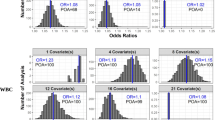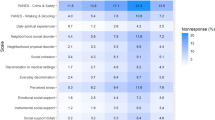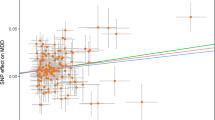Abstract
Socioeconomic status (SES), often conceptualized as income, education, or occupation, is associated with risk for disease morbidity and psychopathology. Recent research has focused on the potential biological mechanisms linking lower SES and poor outcomes; much of this work has examined the relationship between SES and markers of systemic inflammation. The strength of the estimated association between SES and inflammatory markers varies widely across individual studies. Thus, we used meta-analytic techniques to quantify the magnitude of this relationship. To accomplish this, PubMed and PsycINFO were searched for papers that reported on SES and two commonly measured systemic inflammatory markers, C-reactive protein (CRP) and interleukin-6 (IL-6). Peer-reviewed, empirical papers conducted in non-patient populations were included. Data from 43 papers (N = 111,156) reporting a total of 63 relevant effect sizes were included in analyses. SES, broadly defined, was significantly associated with both levels of CRP (Z = 0.12; 95% CI, 0.09–0.16) and IL-6 (Z = 0.15; 95% CI, 0.12–0.18); individuals with lower SES showed higher levels of systemic inflammation. Subanalyses demonstrated that studies operationalizing SES as either levels of income or educational attainment also found significant associations with both CRP and IL-6. Moderator analyses revealed that effect sizes varied based on sample characteristics and analysis approaches. Lower SES is associated with significantly elevated levels of inflammatory markers of disease risk. Thus, pro-inflammatory pathways are likely an important mechanism translating socioeconomic inequalities into mental and physical health disparities.
This is a preview of subscription content, access via your institution
Access options
Subscribe to this journal
Receive 12 print issues and online access
$259.00 per year
only $21.58 per issue
Buy this article
- Purchase on Springer Link
- Instant access to full article PDF
Prices may be subject to local taxes which are calculated during checkout



Similar content being viewed by others
References
Adler NE, Boyce T, Chesney MA, Cohen S, Folkman S, Kahn RL, et al. Socioeconomic status and health: the challenge of the gradient. Am Psychol. 1994;49:15–24. https://doi.org/10.1037/0003-066X.49.1.15
Marmot MG. Status syndrome: a challenge to medicine. J Am Med Assoc. 2006;295:1304–7. https://doi.org/10.1001/jama.295.11.1304
Lorant V, Deliège D, Eaton W, Robert A, Philippot P, Ansseau M. Socioeconomic inequalities in depression: a meta-analysis. Am J Epidemiol. 2003;157:98–112. https://doi.org/10.1093/aje/kwf182
Agerbo E, Sullivan PF, Vilhjálmsson BJ, et al. Polygenic risk score, parental socioeconomic status, family history of psychiatric disorders, and the risk for schizophrenia: a Danish population-based study and meta-analysis. JAMA Psychiatry. 2015;72:635–41. https://doi.org/10.1001/jamapsychiatry.2015.0346
Clark AM, DesMeules M, Luo W, Duncan AS, Wielgosz A. Socioeconomic status and cardiovascular disease: risks and implications for care. Nat Rev Cardiol. 2009;6:712–22. https://doi.org/10.1038/nrcardio.2009.163
Everson SA, Maty SC, Lynch JW, Kaplan GA. Epidemiologic evidence for the relation between socioeconomic status and depression, obesity, and diabetes. J Psychosom Res. 2002;53:891–5.
Shishehbor MH. Association of socioeconomic status with functional capacity, heart rate recovery, and all-cause mortality. JAMA. 2006;295:784 https://doi.org/10.1001/jama.295.7.784
Gimeno D, Kivimäki M, Brunner EJ, et al. Associations of C-reactive protein and interleukin-6 with cognitive symptoms of depression: 12-year follow-up of the Whitehall II study. Psychol Med. 2009;39:413 https://doi.org/10.1017/S0033291708003723
Davidson KW, Schwartz JE, Kirkland SA, et al. Relation of inflammation to depression and incident coronary heart disease (from the Canadian Nova Scotia Health Survey [NSHS95] Prospective Population Study). Am J Cardiol. 2009;103:755–61. https://doi.org/10.1016/j.amjcard.2008.11.035
Rost NS, Wolf PA, Kase CS, et al. Plasma concentration of C-reactive protein and risk of ischemic stroke and transient ischemic attack: the Framingham study. Stroke. 2001;32:2575–9. https://doi.org/10.1161/HS1101.098151
Möhlenkamp S, Lehmann N, Moebus S, et al. Quantification of coronary atherosclerosis and inflammation to predict coronary events and all-cause mortality. J Am Coll Cardiol. 2011;57:1455–64. https://doi.org/10.1016/j.jacc.2010.10.043
Cohen S, Janicki-Deverts D, Miller GE. Psychological stress and disease. JAMA. 2007;298:1685–7. https://doi.org/10.1001/jama.298.14.1685
Mora S, Lee I-M, Buring JE, Ridker PM. Association of physical activity and body mass index with novel and traditional cardiovascular biomarkers in women. JAMA. 2006;295:1412–9. http://jama.ama-assn.org/cgi/content/abstract/295/12/1412
Shiels MS, Katki HA, Freedman ND, et al. Cigarette smoking and variations in systemic immune and inflammation markers. J Natl Cancer Inst. 2014;106:1–8. https://doi.org/10.1093/jnci/dju294
Woodward M, Rumley A, Tunstall-Pedoe H, Lowe GDO. Associations of blood rheology and interleukin-6 with cardiovascular risk factors and prevalent cardiovascular disease. Br J Haematol. 1999;104:246–57. https://doi.org/10.1046/j.1365-2141.1999.01158.x
Mendall Ma, Patel P, Asante M, et al. Relation of serum cytokine concentrations to cardiovascular risk factors and coronary heart disease. Heart. 1997;78:273–7. https://doi.org/10.1136/hrt.78.3.273
Steptoe A, Owen N, Kunz-Ebrecht S, Mohamed-Ali V. Inflammatory cytokines, socioeconomic status, and acute stress responsivity. Brain Behav Immun. 2002;16:774–84. https://doi.org/10.1016/S0889-1591(02)00030-2
Ford ES. Does exercise reduce inflammation? Physical activity and C-reactive protein among U.S. adults. Epidemiology. 2002;13:561–8. https://doi.org/10.1097/01.EDE.0000023965.92535.C0
Marmot M. Social determinants of health inequalities. Lancet. 2005;365:1099–104. https://doi.org/10.1016/S0140-6736(05)71146-6
Baumeister D, Akhtar R, Ciufolini S, Pariante CM, Mondelli V. Childhood trauma and adulthood inflammation: a meta-analysis of peripheral C-reactive protein, interleukin-6 and tumour necrosis factor-α. Mol Psychiatry. 2016;21:642–9. https://doi.org/10.1038/mp.2015.67
O’Connor M-F, Bower JE, Jin H, et al. To assess, to control, to exclude: effects of biobehavioral factors on circulating inflammatory markers. Brain Behav Immun. 2009;23:887–97. https://doi.org/10.1016/j.bbi.2009.04.005
Egger M, Davey Smith G, Schneider M, Minder C. Bias in meta-analysis detected by a simple, graphical test. BMJ. 1997;315:629–34. https://doi.org/10.1136/BMJ.315.7109.629
Begg CB, Mazumdar M. Operating characteristics of a rank correlation test for publication bias. Source: Biom. 1994;50:1088–101.
John-Henderson N, Jacobs EG, Mendoza-Denton R, Francis DD. Wealth, health, and the moderating role of implicit social class bias. Ann Behav Med. 2013;45:173–9. https://doi.org/10.1007/s12160-012-9443-9
Duncan GJ, Magnuson K. Socioeconomic status and cognitive functioning: moving from correlation to causation. Wiley Interdiscip Rev Cogn Sci. 2012;3:377–86. https://doi.org/10.1002/wcs.1176
Howren MB, Lamkin DM, Suls J. Associations of depression with C-reactive protein, IL-1, and IL-6: a meta-analysis. Psychosom Med. 2009;71:171–86. https://doi.org/10.1097/PSY.0b013e3181907c1b
Irwin MR, Olmstead R, Carroll JE. Sleep disturbance, sleep duration, and inflammation: a systematic review and meta-analysis of cohort studies and experimental sleep deprivation. Biol Psychiatry. 2016;80:40–52. https://doi.org/10.1016/j.biopsych.2015.05.014
Lantz PM, House JS, Lepkowski JM, Williams DR, Mero RP, Chen J. Socioeconomic factors, health behaviors, and mortality prospective study of US adults. J Am Med Assoc. 1998;279:1703–8.
Liu RS, Aiello AE, Mensah FK, et al. Socioeconomic status in childhood and C reactive protein in adulthood: a systematic review and meta-analysis. J Epidemiol Community Heal. 2017;71:817–26. https://doi.org/10.1136/jech-2016-208646
Wang Y, Beydoun MA. The obesity epidemic in the United States - Gender, age, socioeconomic, racial/ethnic, and geographic characteristics: A systematic review and meta-regression analysis. Epidemiol Rev. 2007;29:6–28. https://doi.org/10.1093/epirev/mxm007
Hiscock R, Bauld L, Amos A, Fidler JA, Munafò M. Socioeconomic status and smoking: a review. Ann N Y Acad Sci. 2012;1248:107–23. https://doi.org/10.1111/j.1749-6632.2011.06202.x
Gabay C, Kushner I. Acute-phase proteins and other systemic responses to inflammation. N Engl J Med. 1999;340:448–54.
Wilkinson R, Pickett K. The spirit level: why more equal societies alomost always do better. Nurs Stand. 2009;12:14 https://doi.org/10.1080/15700763.2011.577928
Sampson RJ, Morenoff JD, Gannon-Rowley T. Assessing “Neighborhood Effects”: social processes and new directions in research. Annu Rev Sociol. 2002;28:443–78. https://doi.org/10.1146/annurev.soc.28.110601.141114
Operario D, Adler NE, Williams DR. Subjective social status: reliability and predictive utility for global health. Psychol Heal. 2004;19:237–46. https://doi.org/10.1080/08870440310001638098
Epel ES, Crosswell AD, Mayer SE. et al. More than a feeling:a unified view of stress measurement for population science. Front Neuroendocrinol. 2018;49:146–69. https://doi.org/10.1016/j.yfrne.2018.03.001.
Appleton AA, Buka SL, McCormick MC, Koenen KC, Loucks EB, Kubzansky LD. The association between childhood emotional functioning and adulthood inflammation is modified by early-life socioeconomic status. Heal Psychol. 2012;31:413–22. https://doi.org/10.1037/a0027300
Boylan JM, Ryff CD. Varieties of anger and the inverse link between education and inflammation: toward an integrative framework. Psychosom Med. 2013;75:566–74. https://doi.org/10.1097/PSY.0b013e31829683bd
Broyles ST, Staiano AE, Drazba KT, Gupta AK, Sothern M, Katzmarzyk PT. Elevated C-reactive protein in children from risky neighborhoods: evidence for a stress pathway linking neighborhoods and inflammation in children. PLoS ONE 2012;7:1–9. https://doi.org/10.1371/journal.pone.0045419.
Carroll JE, Cohen S, Marsland AL. Early childhood socioeconomic status is associated with circulating interleukin-6 among mid-life adults. Brain Behav Immun. 2011;25:1468–74. https://doi.org/10.1016/j.bbi.2011.05.016
Chapman BP, Khan A, Harper M, et al. Gender, race/ethnicity, personality, and interleukin-6 in urban primary care patients. Brain Behav Immun. 2009;23:636–42. https://doi.org/10.1016/j.bbi.2008.12.009
Chiang JJ, Bower JE, Almeida DM, Irwin MR, Seeman TE, Fuligni AJ. Socioeconomic status, daily affective and social experiences, and inflammation during adolescence. Psychosom Med. 2015;77:256–66. https://doi.org/10.1097/PSY.0000000000000160
Clark CR, Ridker PM, Ommerborn MJ, et al. Cardiovascular inflammation in healthy women: multilevel associations with state-level prosperity, productivity and income inequality. BMC Public Health. 2012;12:211 https://doi.org/10.1186/1471-2458-12-211
Cole SW, Arevalo JMG, Manu K, et al. Antagonistic pleiotropy at the human IL6 promoter confers genetic resilience to the pro-inflammatory effects of adverse social conditions in adolescence. Dev Psychol. 2011;47:1173–80. https://doi.org/10.1037/a0023871
Cozier YC, Albert MA, Castro-Webb N, et al. Neighborhood socioeconomic status in relation to serum biomarkers in the black women’s health study. J Urban Health. 2016;93:279–91. https://doi.org/10.1007/s11524-016-0034-0
Cushman M, McClure LA, Howard VJ, Jenny NS, Lakoski SG, Howard G. Implications of increased C-reactive protein for cardiovascular risk stratification in black and white men and women in the US. Clin Chem. 2009;55:1627–36. https://doi.org/10.1373/clinchem.2008.122093
Dowd JB, Haan MN, Blythe L, Moore K, Aiello AE. Socioeconomic gradients in immune response to latent infection. Am J Epidemiol. 2008;167:112–20. https://doi.org/10.1093/aje/kwm247
Dowd JB, Zajacova A, Aiello AE. Predictors of inflammation in U.S. children aged 316 years. Am J Prev Med. 2010;39:314–20. https://doi.org/10.1016/j.amepre.2010.05.014
Elliot AJ, Chapman BP. Socioeconomic status, psychological resources, and inflammatorymarkers: results from the MIDUS study. Heal Psychol. 2016;35:1205–13. https://doi.org/10.1037/hea0000392
Fedewa MV, Das BM, Forehand RL, Evans EM. Area-level socioeconomic status, adiposity, physical activity, and inflammation in young adults, 2013. Prev Chronic Dis. 2014;11:E130 https://doi.org/10.5888/pcd11.140090
Gallo LC, Fortmann AL, de Los Monteros KE, et al. Individual and neighborhood socioeconomic status and inflammation in Mexican American women: what is the role of obesity? Psychosom Med. 2012;74:535–42. https://doi.org/10.1097/PSY.0b013e31824f5f6d
Herd P, Karraker A, Friedman E. The social patterns of a biological risk factor for disease: race, gender, socioeconomic position, and C-reactive protein. J Gerontol B Psychol Sci Soc Sci. 2012;67:503–13. https://doi.org/10.1093/geronb/gbs048
Hostinar CE, Ross KM, Chen E, Miller GE. Modeling the association between lifecourse socioeconomic disadvantage and systemic inflammation in healthy adults: The role of self-control. Heal Psychol. 2015;34:580–90. https://doi.org/10.1037/hea0000130.
Janicki-Deverts D, Cohen S, Matthews KA, Cullen MR. History of unemployment predicts future elevations in C-reactive protein among male participants in the coronary artery risk development in young adults (CARDIA) study. Ann Behav Med. 2008;36:176–85. https://doi.org/10.1007/s12160-008-9056-5
Joseph J, Depp C, Martin AS, et al. Associations of high sensitivity C-reactive protein levels in schizophrenia and comparison groups. Schizophr Res. 2015;168:456–60. https://doi.org/10.1016/j.schres.2015.08.019
Koster A, Bosma H, Penninx BWJH, et al. Association of inflammatory markers with socioeconomic status. J Gerontol A Biol Sci Med Sci. 2006;61:284–90. https://doi.org/10.1093/gerona/61.3.284
Loucks EB, Sullivan LM, Hayes LJ, et al. Association of educational level with inflammatory markers in the Framingham Offspring Study. Am J Epidemiol. 2006;163:622–8. https://doi.org/10.1093/aje/kwj076
Loucks EB, Berkman LF, Gruenewald TL, Seeman TE. Relation of social integration to inflammatory marker concentrations in men and women 70 to 79 years. Am J Cardiol. 2006;97:1010–6. https://doi.org/10.1016/j.amjcard.2005.10.043
Marsland AL, Petersen KL, Sathanoori R, et al. Interleukin-6 covaries inversely with cognitive performance among middle-aged community volunteers. Psychosom Med. 2006;68:895–903. https://doi.org/10.1097/01.psy.0000238451.22174.92
McDade TW, Hawkley LC, Cacioppo JT. Psychosocial and behavioral predictors of inflammation in middle-aged and older adults: the Chicago health, aging, and social relations study. Psychosom Med. 2006;68:376–81. https://doi.org/10.1097/01.psy.0000221371.43607.64
Miller GE, Chen E, Fok AK, et al. Low early-life social class leaves a biological residue manifested by decreased glucocorticoid and increased proinflammatory signaling. Proc Natl Acad Sci USA. 2009;106:14716–21. https://doi.org/10.1073/pnas.0902971106
Miller GE, Chen E. Harsh family climate in early life presages the emergence of a proinflammatory phenotype in adolescence. Psychol Sci. 2010;21:848–56. https://doi.org/10.1177/0956797610370161
Muennig P, Sohler N, Mahato B. Socioeconomic status as an independent predictor of physiological biomarkers of cardiovascular disease: Evidence from NHANES. Prev Med (Baltim). 2007;45:35–40. https://doi.org/10.1016/j.ypmed.2007.04.005
Mwendwa DT, Ali MK, Sims RC, et al. Dispositional depression and hostility are associated with inflammatory markers of cardiovascular disease in African Americans. Brain Behav Immun. 2013;28:72–82. https://doi.org/10.1016/j.bbi.2012.10.019
Paalani M, Lee JW, Haddad E, Tonstad S. Determinants of inflammatory markers in a bi-ethnic population. Ethn Dis. 2011;21:142–9.
Paul K, Boutain D, Agnew K, Thomas J, Hitti J. The relationship between racial identity, income, stress and C-reactive protein among parous women: implications for preterm birth disparity research. J Natl Med Assoc. 2008;100:540–6. https://doi.org/10.1016/S0027-9684(15)31300-6
Petersen KL, Marsland AL, Flory J, Votruba-Drzal E, Muldoon MF, Manuck SB. Community socioeconomic status is associated with circulating interleukin-6 and C-reactive protein. Psychosom Med. 2008;70:646–52. https://doi.org/10.1097/PSY.0b013e31817b8ee4
Pietras SA, Goodman E. Socioeconomic status gradients in inflammation in adolescence. Psychosom Med. 2013;75:442–8. https://doi.org/10.1097/PSY.0b013e31828b871a
Schmeer KK, Yoon AJ. Home sweet home? Home physical environment and inflammation in children. Soc Sci Res. 2016;60:236–48. https://doi.org/10.1016/j.ssresearch.2016.04.001
Schmeer KK, Yoon A. Socioeconomic status inequalities in low-grade inflammation during childhood. Arch Dis Child. 2016;101:1043–7. https://doi.org/10.1136/archdischild-2016-310837
Schreier HMC, Chen E. Socioeconomic status in one’s childhood predicts offspring cardiovascular risk. Brain Behav Immun. 2010;24:1324–31. https://doi.org/10.1016/j.bbi.2010.06.007
Schreier HMC, Roy LB, Frimer LT, Chen E. Family chaos and adolescent inflammatory profiles. Psychosom Med. 2014;76:460–7. https://doi.org/10.1097/PSY.0000000000000078
Shanahan L, Freeman J, Bauldry S. Is very high C-reactive protein in young adults associated with indicators of chronic disease risk? Psychoneuroendocrinology. 2014;40:76–85. https://doi.org/10.1016/j.psyneuen.2013.10.019
Sin NL, Graham-Engeland JE, Ong AD, Almeida DM. Affective reactivity to daily stressors is associated with elevated inflammation. Health Psychol. 2015;34:1154–65. https://doi.org/10.1037/hea0000240
Sturgeon JA, Arewasikporn A, Okun MA, Davis MC, Ong AD, Zautra AJ. The psychosocial context of financial stress: implications for inflammation and psychological health. Psychosom Med. 2015. https://doi.org/10.1097/PSY.0000000000000276.
Taylor SE, Lehman BJ, Kiefe CI, Seeman TE. Relationship of early life stress and psychological functioning to adult C-reactive protein in the coronary artery risk development in young adults study. Biol Psychiatry. 2006;60:819–24. https://doi.org/10.1016/j.biopsych.2006.03.016
Zhang X, Shu X-OO, Signorello LB, et al. Correlates of high serum C-reactive protein levels in a socioeconomically disadvantaged population. Dis Markers. 2008;24:351–9. https://doi.org/10.1155/2008/509138
Acknowledgements
K.L.H. is funded by the National Institutes of Health (F32 MH107129), the Brain and Behavior Research Foundation (Young Investigator Award 23819), Klingenstein Third Generation Foundation, and a Jacobs Foundation Early Career Research Fellowship. The authors thank Lillian Dillard for her assistance with literature searches and coding; and Allison Appleton, Jennifer Morozink Boylan, Ben Chapman, Edith Chen, Yvette Cozier, Ari Elliot, Andrew Fuligni, Neha John-Henderon, Annemarie Koster, Thomas McDade, Gregory Miller, Markus Schafer, Kammi Schmeer, and Hannah Schreier for providing relevant data and information from their published papers on SES and inflammation.
Author information
Authors and Affiliations
Corresponding author
Ethics declarations
Conflict of interest
Dr. Humphreys received financial support from NIH, the Brain and Behavior Research Foundation, the Klingenstein Third Generation Foundation, and the Jacobs Foundation. Dr. Muscatell and Ms. Brosso declare that they have no conflict of interest.
Electronic supplementary material
Rights and permissions
About this article
Cite this article
Muscatell, K.A., Brosso, S.N. & Humphreys, K.L. Socioeconomic status and inflammation: a meta-analysis. Mol Psychiatry 25, 2189–2199 (2020). https://doi.org/10.1038/s41380-018-0259-2
Received:
Revised:
Accepted:
Published:
Issue Date:
DOI: https://doi.org/10.1038/s41380-018-0259-2
This article is cited by
-
Socioeconomic inequalities in early adulthood disrupt the immune transcriptomic landscape via upstream regulators
Scientific Reports (2024)
-
C-reactive protein moderates associations between racial discrimination and ventromedial prefrontal cortex activation during attention to threat in Black American women
Neuropsychopharmacology (2024)
-
The Cantril Ladder elicits thoughts about power and wealth
Scientific Reports (2024)
-
Genetic and biological drivers of prostate cancer disparities in Black men
Nature Reviews Urology (2023)
-
Associations of the gut microbiome with psychoneurological symptom cluster in women with gynecologic cancers: a longitudinal study
Supportive Care in Cancer (2023)



